How to implement auditing in Django models

Implementing auditing in Django models involves tracking changes made to model instances and storing this information in a separate auditing model. Here's a basic guide on how to implement auditing in Django models:
- Create an Auditing Model: First, create a model to store audit logs. This model should include fields to store information about the action (create, update, delete), the user who performed the action (if available), the timestamp, and any relevant details about the change.
python# models.py
from django.db import models
from django.contrib.contenttypes.models import ContentType
from django.contrib.contenttypes.fields import GenericForeignKey
class AuditLog(models.Model):
action = models.CharField(max_length=10) # 'create', 'update', or 'delete'
user = models.ForeignKey('auth.User', on_delete=models.SET_NULL, null=True, blank=True)
timestamp = models.DateTimeField(auto_now_add=True)
details = models.TextField(blank=True)
# GenericForeignKey to associate audit log with any model
content_type = models.ForeignKey(ContentType, on_delete=models.CASCADE)
object_id = models.PositiveIntegerField()
content_object = GenericForeignKey('content_type', 'object_id')
- Implement Auditing Logic: Define a function or method to create audit logs whenever a model instance is created, updated, or deleted. You can achieve this using Django's signals.
python# signals.py
from django.db.models.signals import post_save, pre_delete
from django.dispatch import receiver
from .models import YourModel, AuditLog
@receiver(post_save, sender=YourModel)
def log_object_change(sender, instance, created, **kwargs):
action = 'create' if created else 'update'
details = 'Created' if created else 'Updated'
AuditLog.objects.create(
action=action,
user=instance.modified_by, # If you have a modified_by field in your model
content_type=ContentType.objects.get_for_model(instance),
object_id=instance.id,
details=details
)
@receiver(pre_delete, sender=YourModel)
def log_object_delete(sender, instance, **kwargs):
AuditLog.objects.create(
action='delete',
user=instance.modified_by, # If you have a modified_by field in your model
content_type=ContentType.objects.get_for_model(instance),
object_id=instance.id,
details='Deleted'
)
- Connect Signals: Ensure that the signals are connected in your Django app. This is typically done in the
ready()method of your app'sapps.py.
python# apps.py
from django.apps import AppConfig
class YourAppConfig(AppConfig):
default_auto_field = 'django.db.models.BigAutoField'
name = 'your_app'
def ready(self):
import your_app.signals # noqa
- Apply Migrations: After creating the audit log model and signals, apply migrations to create the necessary database tables.
bashpython manage.py makemigrations
python manage.py migrate
With these steps, your Django models will now be audited, and changes made to model instances will be logged in the AuditLog model. Make sure to adjust the implementation according to your specific requirements and models.
-
Popular Post
- How to optimize for Google's About This Result feature for local businesses
- How to implement multi-language support in an Express.js application
- How to handle and optimize for changes in mobile search behavior
- How to handle CORS in a Node.js application
- How to use Vue.js with a UI framework (e.g., Vuetify, Element UI)
- How to configure Laravel Telescope for monitoring and profiling API requests
- How to create a command-line tool using the Commander.js library in Node.js
- How to implement code splitting in a React.js application
- How to use the AWS SDK for Node.js to interact with various AWS services
- How to use the Node.js Stream API for efficient data processing
- How to implement a cookie parser middleware in Node.js
- How to implement WebSockets for real-time communication in React
-
Latest Post
- How to implement a dynamic form with dynamic field styling based on user input in Next.js
- How to create a custom hook for handling user interactions with the browser's device motion in Next.js
- How to create a custom hook for handling user interactions with the browser's battery status in Next.js
- How to implement a dynamic form with dynamic field visibility based on user input in Next.js
- How to implement a dynamic form with real-time collaboration features in Next.js
- How to create a custom hook for handling user interactions with the browser's media devices in Next.js
- How to use the useSWRInfinite hook for paginating data with a custom loading indicator in Next.js
- How to create a custom hook for handling user interactions with the browser's network status in Next.js
- How to create a custom hook for handling user interactions with the browser's location in Next.js
- How to implement a dynamic form with multi-language support in Next.js
- How to create a custom hook for handling user interactions with the browser's ambient light sensor in Next.js
- How to use the useHover hook for creating interactive image zoom effects in Next.js